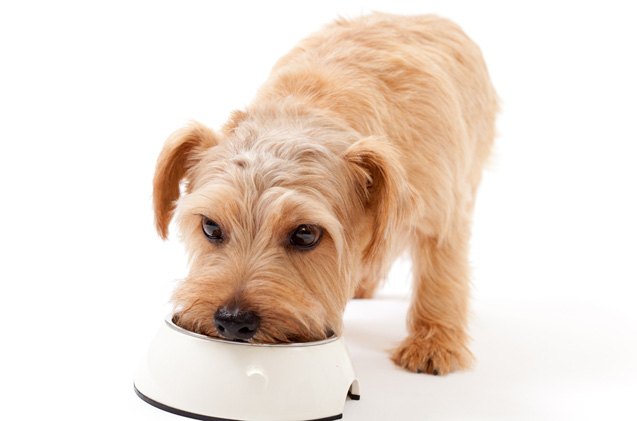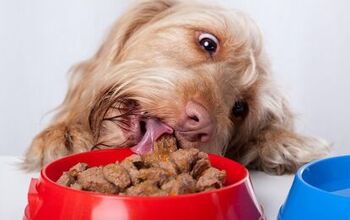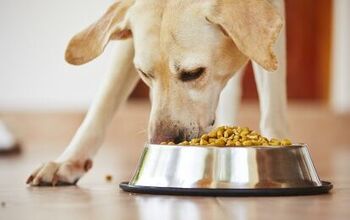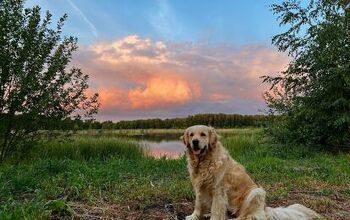Dry Vs. Wet Dog Foods: Which Is The Right Choice? Part 3
In Part 3 of her series on Dry vs. Wet dog food, Sabine Contreras, Canine Care and Nutrition Consultant, goes over a few popular myths of feeding wet food, and leaves us with some tips to keep in mind.
Incorrect information about wet food ranges from simple misinformation to outrageous old wives tales. Let’s have a look at the facts!
“Kibble keeps the teeth clean and exercises the jaws”
First things first—cats and dogs are not “chewers”, they do not have the type of teeth with flat “grinding” surfaces required for significantly reducing the particle size of their food through mastication, like for example humans and cows. They also have no lateral (sideways) movement in their jaws to help the process. The natural way of eating for dogs and cats is to rip at their prey and tear out chunks which are then mostly swallowed whole. Bones are gnawed and crushed, again without any lateral movement of the jaws.
What truly exercises the jaws and keeps teeth clean is the friction from gnawing on tendons, tissue, and bones (or, as the case may be, a good chew toy, regardless whether it’s edible). The much touted “scraping action” of dry foods only happens if the dog actually “crunches down” on the pieces of food, and only around the top of the molars, but not the canine teeth or incisors, and not where cleaning is most needed: at and below the gum line.
The “cleaning action” of special dental kibble comes from its larger size (the pet is forced to “chew”), higher fiber content, and often also a specific coating that changes the chemical composition of the saliva. Sadly the ingredient quality of these products and their nutritional composition leave a lot to be desired.
How easily your dog’s teeth stay clean is also very dependent on genetics. Just like people, some dogs just accumulate plaque and tartar more quickly than others and need extra help—no matter what they eat. Unfortunately a dog I have owned was one of the more unlucky individuals, despite eating a raw diet with plenty of bones to gnaw on, his teeth need frequent attention and were even more difficult to keep clean before I stopped feeding kibble.
I always tell my clients to pay close attention to their dogs’ teeth no matter what they are feeding, and to start my recommended maintenance program for dental and gum health if they aren’t doing it already. Keeping your dog’s mouth healthy is one of the best things you can do to extend his life, since chronic inflammation and infections spread toxins to all vital organs through the blood stream.
“Wet food does not provide the same adequate nutrition as dry food”
Nothing could be further from the truth. If a wet food formulation is labeled as “complete and balanced”, it must conform to the same AAFCO nutrient profiles as dry food and other products.
“Feeding canned food only will make a pet overweight”
While it is true that most canned foods are comparatively higher in fat content, no type of food “makes a pet overweight”; feeding inappropriate amounts does. Don’t “eyeball” portions or rely on the manufacturer’s feeding recommendations, but calculate how many calories the usual dry food portion contains and feed accordingly if you are replacing dry with wet food. If you are adding wet food as a “topping”, don’t forget to reduce the amount of kibble you feed.
“Wet food makes the pet’s stool soft or gives them diarrhea”
The most common cause for soft stools or diarrhea is overfeeding—regardless whether you feed dry or wet food. Start with smaller amounts and increase slowly.
Pets with a sensitive stomach may also react to the higher fat content, so when you begin transitioning to feeding wet food, switch slowly, start with lower fat varieties and reduce the portion size a bit.
Adding a few teaspoons of canned pumpkin (plain without salt added, not the spiced pie filling mix!) to each meal will help to normalize stools quickly.
“You can’t leave out wet food for free-feeding animals”
This is correct—canned food should not be left out for extended periods of time. Free-feeding is not a particularly healthy thing to do though, dogs and cats both are better off eating at set mealtimes and giving the digestive system time to work in between.
If your pet needs to eat more frequent small meals due to medical reasons and you are not home during the day, I recommend feeding two meals consisting of wet food for breakfast and dinner, and putting a small amount of dry food into an electronic feeder or a treat-dispensing toy like a Buster Cube or Tricky Treat Ball, so that the pet has to work for it instead of just eating it from a bowl.
“Wet food is more expensive to feed”
This is one is also true—due to the inclusion of more meat and fewer carbohydrates, higher quality meat ingredients overall, and the more expensive packaging, wet food is generally not as economical to feed as kibble. However, spending a little more on your dog’s diet may save you much more in vet bills over a lifetime.
After all you have read about the benefits of less processed food, even if you do not switch completely, I hope that I have convinced you to at least choose to enrich and enhance your dog’s diet by adding some wet food and feed a lesser amount of kibble.
Tips on Feeding Wet Foods
- If a can is dented, misshapen, or leaking, don’t buy it or feed its content to your pet. Bulging cans are an indication of spoilage and should not be used – exchange them for undamaged product.
- Likewise, if you hear a distinct hissing when opening (other than the normal noise when air enters the can and releases the existing vacuum), do not feed the food and report the problem to the manufacturer.
- Keeping remaining food in an opened can (sealing it with a reusable plastic or rubber lid, or cling wrap) in the refrigerator for a day or two isn’t a problem, but it’s better to transfer the leftovers to a glass or plastic container for storage to prevent oxidation.
- Since the price per weight unit is generally lower for larger cans, owners of small dogs can take advantage of larger containers and freeze smaller portions in suitable containers for later use.
- Freeze canned food in a Kong toy for a wonderful treat that relieves boredom. You don’t have to feed wet food out of a bowl either!
Don’t forget to read Part 1 and Part 2 of the series.
Sabine Contreras is a Canine Care and Nutrition Consultant based out of Los Angeles, California. She specializes in natural, preventive dog care as well as canine nutrition and offers personalized feeding plans for dogs of all sizes, breeds and ages, no matter if they are companions, performance, working or show dogs. She shares her home with a husband, Jack Russell Terrier and five cats.
More by Sabine Contreras























